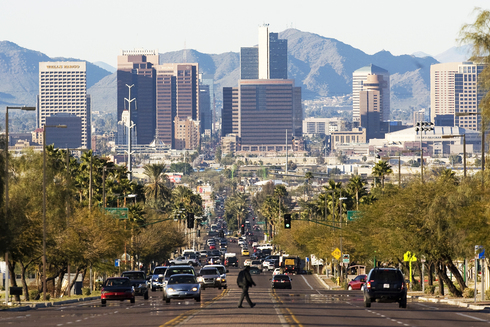Census: Arizona population continued steady growth in 2013

 By Whitney Ogden
By Whitney Ogden
Cronkite News
WASHINGTON – Arizona gained more than 230,000 residents in the past three years, again making it one of the faster-growing states in the nation, according to new Census Bureau estimates.
The Census report released Thursday estimated that the state’s population grew by 234,609 people from the 2010 census to July 1, 2013, climbing above 6.6 million people.
While the 3.7 percent increase was ninth-fastest in the nation, Arizona’s growth in raw numbers was 11th largest in the country, slightly behind Colorado.
The steady increase in the pace of the state’s population growth marks a return from the recession of several years ago, when growth slowed sharply after peaking at more than 190,000 in 2006.
“We were one of the fastest-growing states at the end of ’90s and the beginning of the 2000s,” said Kristen Stephenson, senior economic analyst for the Greater Phoenix Economic Council.
Glenn Hamer, president and CEO of the Arizona Chamber of Commerce and Industry, echoed that statement.
“We were on a rocket ship. We were always one of the fastest-growing states,” Hamer said.
But the numbers dropped after the recession hit in December 2007, falling to around 60,000 by 2009.
“In the short term, economic growth drives the population growth,” said Tom Rex, an associate director at Arizona State University’s W. P. Carey School of Business.
“The recovery wasn’t especially strong after that and the population growth in Arizona slowed,” Rex said.
In the past three years, however, the numbers have inched back up, boosted by births and by people moving to the state.
Migration to the state made up almost half of the increase over the last three years, accounting for more than 37,000 people from July 2012 to July 2013 alone.
But Rex said the latest migration share of the population growth for the state is actually lower than normal. In a typical year, the state has one of the highest migration rates in the nation.
“In recent years that hasn’t been the case because Arizona … was hit much harder in the recession,” Rex said.
Hamer said Arizona’s growth slowed especially because of the housing market crash. He said fewer and fewer people were moving to Arizona, a state that depends on constant population growth to push its economy.
“It is much easier now than it was four or five years ago to move and to sell a home or to buy a home,” Hamer said.
Stephenson could not say whether higher population growth is spurring the economy or the other way around. When it comes to the relationship between Arizona’s economic stability and its annual population growth, Stephenson said they “tend to drive each other.”
“The population is doing better, the economy is doing better,” she said. “Now, which one is causing which? I’m not entirely sure.”
Evan Fuchs, the president of the Arizona Association of Realtors, said that “when you put all these things together, it’s positive for real estate.”
Rex said in the long term “the two sort of work with each other.” He said in Arizona, if the economy is good, the numbers of people moving to the state will increase.
“In general, I think almost all economists in their local areas expect the growth rate will gradually increase,” Rex said. “Maybe somewhere around 2016 Arizona will be back to the historical norm.”














